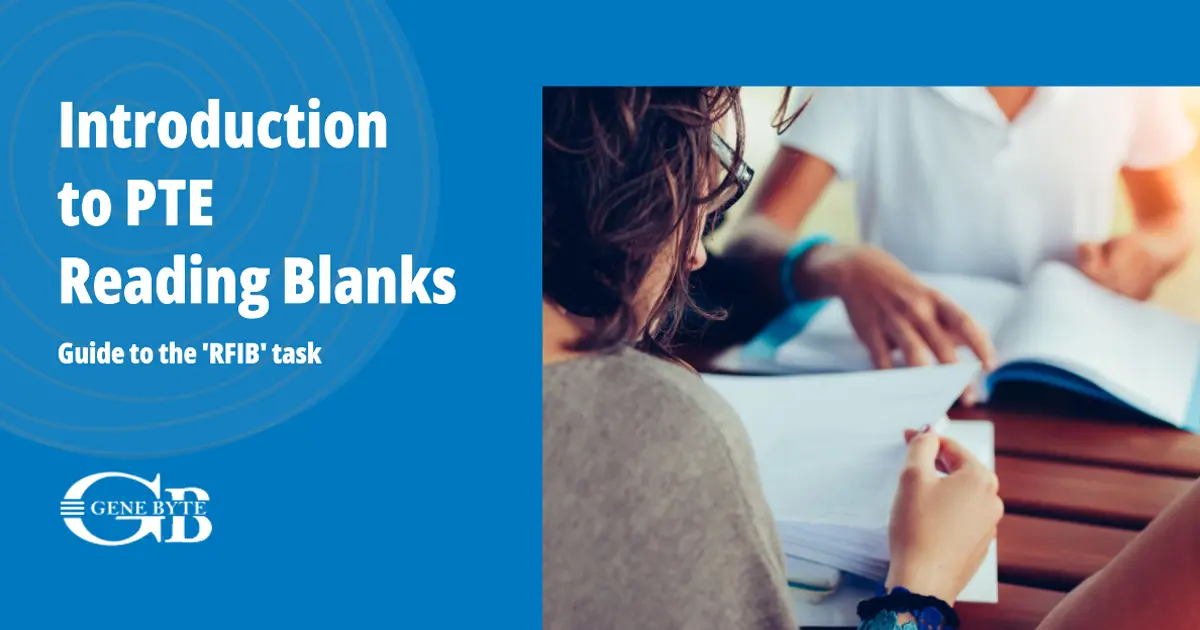Discussing PTE Reading's Fill in the Blanks:
An Essential Guide for Teachers
Unlocking the PTE Reading's Fill in the Blanks Task in PTE Academic for Educators

"Mastering PTE Academic's Reading: Fill in the Blanks goes beyond language proficiency; it's about unlocking the potential of every word to reveal the bigger picture."
Have you considered the challenges and opportunities of the Reading: Fill in the Blanks task in the Reading Section? This crucial part of the PTE Academic test is more than a simple vocabulary exercise; it assesses linguistic proficiency and comprehension.
Key Takeaways
- Task Requirements: Students fill in gaps in a text, testing their vocabulary and understanding of linguistic structures.
- Skills Assessed: This task evaluates reading and cognitive skills, requiring a deep comprehension of the text.
- Effective Strategies: Understanding the task helps educators develop effective teaching methods tailored to its requirements.
- Empowering Educators: Equipping teachers with the tools and insights so that they can transform their approach to the task.
This discussion highlights the importance of effective teaching methodologies and how Genebyte's solutions can support educators in nurturing proficient English language users.

Brief Overview of the PTE Academic Test
The Pearson Test of English (PTE) Academic, a cornerstone in the landscape of English proficiency assessment, is a computer-based test embraced globally for its precision and reliability. Pioneered by Pearson, this test rigorously evaluates a candidate's English language skills across four critical modules: Speaking, Writing, Reading, and Listening. Each module is meticulously designed to mirror real-life academic and immigration scenarios, making PTE Academic a trusted standard in gauging English language proficiency.
At Genebyte, we recognize the pivotal role this test plays in shaping the academic and professional trajectories of countless individuals. Our B2B SaaS solution, specifically tailored for coaching institutes, is engineered to align seamlessly with the PTE Academic's structure, providing educators with a robust toolkit to enhance their teaching methodologies.
Importance of the Reading: Fill in the Blanks Section in PTE Academic
Among the various challenges presented by the PTE Academic, the Reading: Fill in the Blanks section stands out as a critical component. This segment, which forms an integral part of the Reading module, is not just about testing vocabulary. It delves deeper into assessing a student's ability to comprehend texts and apply contextual and grammatical knowledge effectively.
-
Key Elements of the Task:
- Task Description: Students encounter a text with several gaps and must select appropriate words from a given list to fill these blanks.
- Skills Assessed: Beyond mere vocabulary, this task evaluates reading comprehension, contextual understanding, and the application of grammatical rules.
-
Genebyte's Edge in Teaching This Task:
- Customized Practice Sessions: Genebyte's platform offers tailored practice sessions, mimicking the actual PTE format, allowing students to hone their skills in a realistic testing environment.
- Progress Tracking and Analytics: Our solution includes advanced tracking and analytics, providing educators with insights into each student's performance and areas needing improvement.
Real-Life Application and Significance:
- Academic and Professional Relevance: Mastery of this task is not only crucial for excelling in PTE Academic but also equips students with essential reading and comprehension skills, vital in academic and professional settings.
In conclusion, the Reading: Fill in the Blanks section is more than a test of language; it's a measure of a student's ability to navigate complex textual information. As we delve further into this article, we will explore the nuances of this task and how Genebyte's innovative solutions are revolutionizing the way educators prepare students for this challenge, ultimately leading to higher success rates in the PTE Academic.

Understanding the Reading: Fill in the Blanks
Description of the Task
In Reading: Fill in the Blanks task, which follows Re-order Paragraph task, candidates encounter a unique challenge that goes beyond basic language proficiency. This task involves a series of texts, each containing several gaps. These gaps are to be filled from a given list of words, testing the candidate's ability to accurately understand and complete the text.
-
Task Structure:
- Text Presentation: The texts, typically up to 80 words in length, are designed to mimic real-world scenarios, offering diverse topics and complexity levels.
- Gap Characteristics: The gaps are strategically placed to test various aspects of language understanding, from simple vocabulary to complex syntactical structures.
-
Nature of Words for Filling:
- Word Types: The list of words provided for gaps includes a mix of nouns, verbs, adjectives, and adverbs, each serving to test different aspects of language proficiency.
- Selection Criteria: Words are chosen to evaluate the candidate's ability to discern subtle differences in meaning and usage in various contexts.
Skills Assessed in This Task
The Reading: Fill in the Blanks task is not just a test of vocabulary; it's an assessment of a candidate's comprehensive language skills, particularly focusing on:
-
Reading Skill:
- Comprehension: Ability to understand the overall context and specific details within the text.
- Inference: Skill in deducing meanings and relations of parts of the text not explicitly stated.
-
Grammar and Contextual Knowledge:
- Grammatical Accuracy: Understanding of syntax and grammatical structures to choose words that fit grammatically.
- Contextual Application: Proficiency in applying contextual knowledge to select words that make sense within the overall theme and tone of the text.
| Component | Description |
|---|---|
| Text Length | Up to 80 words |
| Gap Types | Nouns, verbs, adjectives, adverbs |
| Skills Tested | Reading comprehension, inference, grammatical accuracy, contextual application |
Genebyte's B2B SaaS solution for coaching institutes is specifically designed to enhance these skills. Our platform offers a range of practice exercises and mock tests that mirror the structure and complexity of the actual PTE Reading: Fill in the Blanks task. This not only prepares students for the test but also develops their overall English language proficiency, a key goal in any language learning curriculum.

The Role of Educators
Educators' Importance in Guiding Students
In the context of PTE Academic's Reading: Fill in the Blanks, educators play a pivotal role in shaping the learning journey of their students. This task, while seemingly straightforward, poses numerous challenges that can be best navigated with the guidance of a skilled educator.
- Understanding the Challenges:
- Diverse Vocabulary: Students often struggle with the broad range of vocabulary required for this task.
- Contextual Understanding: Many find it challenging to apply words in varying contexts appropriately.
- Grammatical Nuances: Grasping the grammatical aspects that govern word choice can be a hurdle for non-native speakers.
| Difficulty | Description |
|---|---|
| Vocabulary Range | Difficulty in understanding and applying a wide range of words |
| Contextual Usage | Challenges in using words correctly in different contexts |
| Grammatical Rules | Struggle with understanding syntax and grammar in text completion |

Key Components of the Task
Prompt Length and Complexity
In the Reading: Fill in the Blanks section of the PTE Academic, the length and complexity of the prompt play a crucial role in determining the level of difficulty faced by students. These texts, typically up to 80 words in length, are carefully crafted to assess a wide array of reading skills.
- Impact of Text Length:
- Short Texts: These often require a precise understanding of vocabulary and grammar, as each word plays a significant role.
- Longer Texts: Longer prompts may pose challenges in maintaining contextual coherence and understanding the overall narrative flow.
| Text Length | Challenges |
|---|---|
| Short Texts | Precise understanding of each word and grammar |
| Longer Texts | Maintaining coherence and overall narrative understanding |
Time Management
One of the unique aspects of the Reading: Fill in the Blanks task is the absence of a specific time limit. This requires students to develop effective time management skills, balancing accuracy with efficiency.
- Time to Answer:
- Self-Paced: Students must learn to gauge their pace, ensuring they complete the task effectively within the overall time frame of the Reading section.
- Strategic Allocation: Educators should focus on teaching students how to allocate time based on the complexity of each text.
Strategies for Time Management in Reading: Fill in the Blanks
- Quick analysis of text length and complexity.
- Allocating more time to longer or more complex texts.
- Practicing under timed conditions to develop a sense of pacing.

Theoretical Foundations
Linguistic Theory Behind the Task
The Reading: Fill in the Blanks component in the PTE Academic is deeply rooted in linguistic theory, particularly focusing on grammar and syntax. This aspect is crucial as it forms the foundation upon which students' language proficiency is evaluated.
- Grammar and Syntax:
- Role in Word Selection: Understanding grammar is vital for selecting the correct word that fits both the meaning and grammatical structure of the sentence.
- Syntax Awareness: Recognizing sentence structures helps in predicting the type of word that should fill the gap (noun, verb, adjective, etc.).
| Grammar/Syntax Aspect | Importance in Task |
|---|---|
| Word Order | Determines how sentences are formed and aids in understanding sentence structure |
| Part of Speech | Helps in identifying the correct type of word needed for each blank |
Contextual Application
Beyond grammar, the task requires a strong ability to comprehend and apply contextual knowledge.
- Comprehension and Contextual Understanding:
- Textual Coherence: Grasping the overall theme and flow of the text is essential for choosing words that maintain coherence.
- Contextual Clues: Identifying keywords and phrases in the text that hint at the correct word choice.
Enhancing Comprehension and Contextual Understanding
- Encouraging extensive reading to familiarize with different writing styles and contexts.
- Practice exercises focusing on identifying key themes and ideas in a text.
- Analyzing various texts to understand how specific words change meaning depending on the context.

Special Considerations for Educators
Beyond Traditional Teaching: Exploring Innovative Teaching Methods
In the dynamic landscape of PTE Academic preparation, particularly for the Reading: Fill in the Blanks task, the conventional approach to teaching often requires augmentation with more innovative methods.
-
Interactive Learning Techniques:
- Gamification: Incorporating game-like elements in lessons to enhance engagement and motivation.
- Collaborative Learning: Encouraging group activities where students learn from peer interactions and discussions.
-
Technology Integration:
- Digital Tools: Utilizing software and apps that simulate the PTE environment for practice.
- Online Resources: Leveraging a plethora of online materials for diverse and up-to-date content.
Innovative Teaching Methods
- Use of language learning apps and platforms.
- Interactive online quizzes and exercises.
- Role-playing exercises to improve contextual understanding.
Tricks and Tips for Educators
Specialized techniques and focused strategies are essential for educators to effectively guide students through the nuances of Reading: Fill in the Blanks.
-
Special Lessons for Reading Blanks Grammar:
- Focused Grammar Sessions: Tailoring sessions to address common grammatical challenges in the task.
- Contextual Grammar Usage: Teaching grammar not in isolation but in the context of actual PTE-like texts.
-
Developing Strategic Reading Skills:
- Skimming and Scanning Techniques: Training students in rapid reading strategies to identify key information quickly.
- Practice with Varied Texts: Exposing students to texts of different styles and topics to broaden their comprehension skills.
| Tip | Description |
|---|---|
| Contextual Vocabulary Practice | Focus on words in various contexts to enhance understanding |
| Grammar in Context | Emphasize grammar usage in different text types |
| Regular Mock Tests | Conduct mock tests that replicate the PTE exam environment |

How Genebyte's Solutions Cater to Teaching the RFIB Task
At Genebyte, we understand the complexities involved in the Reading: Fill in the Blanks task of the PTE Academic and recognize the crucial role educators play in preparing students for this challenge. Our B2B SaaS solution is specifically designed to address these challenges, providing educators with comprehensive tools to enhance teaching efficacy.
Detailed Explanations for all Blanks
-
Insightful Feedback:
- Our platform offers detailed explanations for every blank in practice exercises, helping students understand the rationale behind each correct answer.
- This approach ensures that learning goes beyond rote memorization to a deeper understanding of language usage.
-
Error Analysis:
- Genebyte's system highlights common errors and provides corrective feedback, enabling students to learn from their mistakes and improve their performance.
Parts of Speech Classification
-
Grammar Focused Learning:
- We emphasize understanding the parts of speech required for each blank, enhancing students' grammatical knowledge and application skills.
- This feature is particularly beneficial for students struggling with the grammatical intricacies of English.
-
Contextual Relevance:
- The platform assists in identifying the appropriate part of speech based on the context of the sentence, improving students' contextual comprehension.
Benefits of Parts of Speech Classification in Teaching
- Enhances grammatical accuracy.
- Improves word choice based on sentence structure.
- Aids in understanding the syntactical flow of texts.
Tailored Tools for Educators
-
Customizable Learning Modules:
- Genebyte's solution offers customizable modules that allow educators to focus on specific areas of the Reading: Fill in the Blanks task, tailoring their teaching to the needs of individual students.
- This flexibility is crucial in addressing the diverse learning styles and requirements of students.
-
Progress Tracking:
- Our platform includes advanced tracking features that enable educators to monitor each student's progress, providing insights into areas where additional focus is needed.
| Tool Feature | Benefit |
|---|---|
| Customizable Modules | Allows focusing on specific student needs |
| Progress Tracking | Monitors student performance and identifies areas for improvement |
| Detailed Feedback | Offers explanations and corrective guidance |

Actionable Tips for Educators and Trainers
To prepare students for the Reading: Fill in the Blanks in PTE Academic:
- Diverse Reading Materials: Expose students to various texts to enhance comprehension and vocabulary.
- Contextual Learning: Teach vocabulary and grammar using real-life examples.
- Regular Mock Tests: Simulate exam conditions for realistic test practice.
- Focused Feedback: Provide detailed feedback on practice exercises to help students learn from their mistakes.
Genebyte's platform supports these strategies with:
- Customized Learning Modules: Customized Learning Modules: Tailored for the Reading: Fill in the Blanks section.
- Interactive Exercises and Feedback: Interactive Exercises and Feedback: Engaging activities with insightful feedback.
- Advanced Analytics: Track progress and identify areas for improvement.
The Reading: Fill in the Blanks task in PTE Academic tests language proficiency and critical reading skills. Effective teaching of this task is essential for student success. Following this task, students move to the Multiple-choice, Choose Single Answer question-type.
Genebyte's B2B SaaS solution combines innovative technology with educational expertise to enhance teaching methodologies. This ensures students are well-prepared for the PTE Academic exam. Discover how Genebyte can transform your PTE Academic preparation. Contact us for more information and start your journey toward educational excellence!
"Elevate your teaching methods and student outcomes with Genebyte!"
Frequently Asked Questions
In PTE Reading's Fill in the Blanks, candidates must select appropriate words from a given list to fill gaps in a text. The task assesses reading and vocabulary skills, requiring an understanding of grammar and context.
The exact number of Fill in the Blanks questions in PTE Reading varies, but it typically ranges from 4 to 5 per test.
While there's no specific time limit for each Fill in the Blanks question, the total PTE Reading section is timed, generally taking about 30-40 minutes to complete all tasks.
Each Fill in the Blanks text in PTE Reading is up to 80 words long, designed to test comprehension within a concise context.
This task is scored based on correctness. Each correctly filled blank awards points, contributing to the overall Reading score.
This task is often referred to as 'Drag and Drop' because candidates drag words from a given list and drop them into the appropriate blanks in the text.
The entire Reading section, including Fill in the Blanks, has a combined time limit of approximately 30-40 minutes.
Key grammatical areas include parts of speech, verb tenses, prepositions, and subject-verb agreement, essential for selecting the right word for each blank.
As of now, there are no announced changes for the Fill in the Blanks task in PTE Reading for 2023. However, staying updated with official PTE resources is recommended for any new updates.
The number can vary, but typically, each Fill in the Blanks task in PTE Academic 2023 will have around 4 to 6 blanks to fill.
No, there is no negative marking in the Fill in the Blanks task of PTE Reading. Only correct answers contribute to the score.
Texts used in this task cover a range of topics and are typically academic or informational in nature, reflecting real-world English usage.
Effective preparation involves practicing with diverse texts, understanding context, improving vocabulary, and familiarizing oneself with common grammatical structures.
Context plays a crucial role as it helps in understanding the overall meaning and theme of the text, guiding the selection of the most appropriate words for the blanks.
Absolutely. This task not only tests but also helps improve reading comprehension, vocabulary, and contextual understanding, enhancing overall English language proficiency.
Educators focus on enhancing students' reading skills, vocabulary, and grammar through varied practices, using real-life examples, and providing targeted feedback.
A strong vocabulary is vital as it enables candidates to accurately choose words that fit both the context and the grammatical structure of the text.
Identifying key words involves understanding the text's main idea and context, paying attention to grammar cues, and using logical reasoning to deduce the correct words.
Common challenges include difficulty in understanding complex vocabulary, grasping the overall context, and applying grammatical rules to choose the correct words.